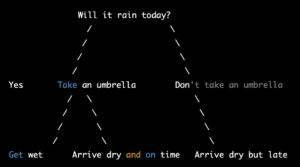A decision tree is a graphical representation of a decision-making process. It is a flowchart-like structure that shows the various possible outcomes of a decision, along with the probabilities and costs associated with each outcome. Decision trees are often used in the field of management science and operations research, as they provide a visual representation of the costs, benefits, and risks associated with different decisions.
Here is an example of a simple decision tree:

In this example, the decision tree shows the different outcomes of the decision to take an umbrella based on whether it rains or not. If it rains and the decision is made to take an umbrella, the individual will arrive dry and on time. If it does not rain, the individual will arrive dry but may be late. If the decision is made not to take an umbrella and it rains, the individual will get wet.
Decision trees can also be used to analyze more complex decisions, such as whether to invest in a new product or expand a business into a new market. In these cases, the tree may have multiple branches and may consider a wider range of factors, such as the potential return on investment, the likelihood of success, and the risks involved.
Decision trees are useful because they provide a structured way to think through a decision and consider all of the possible outcomes. They can help decision-makers to weigh the costs, benefits, and risks of different options and choose the one that is most likely to be successful.
In conclusion, decision trees are a powerful tool for decision-making that can help individuals and organizations to evaluate the potential outcomes of different choices and make informed decisions based on data and analysis.


